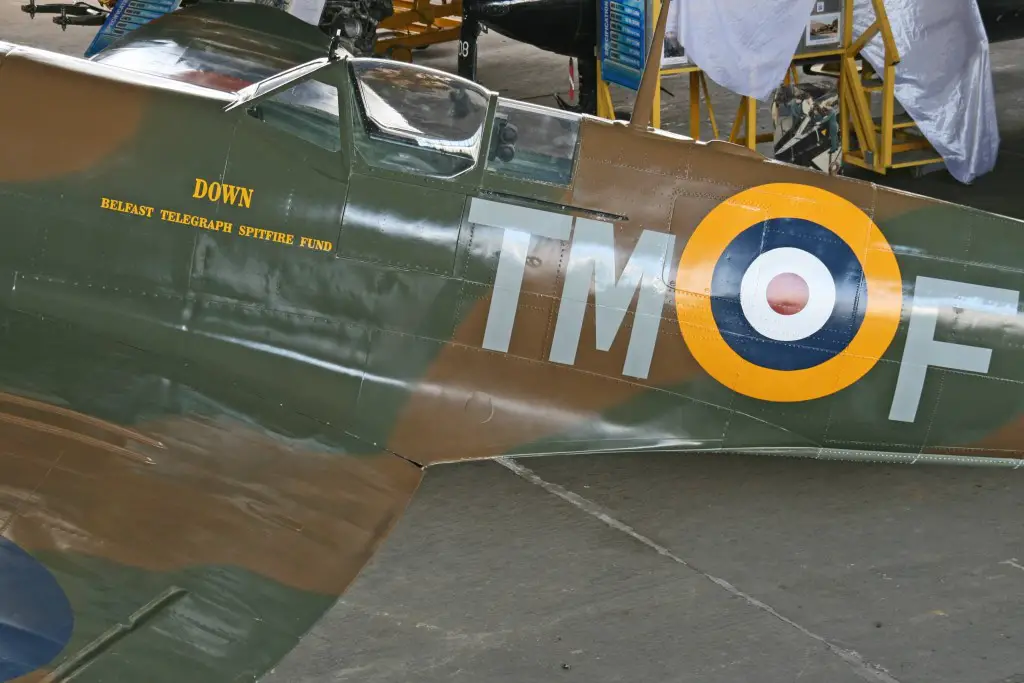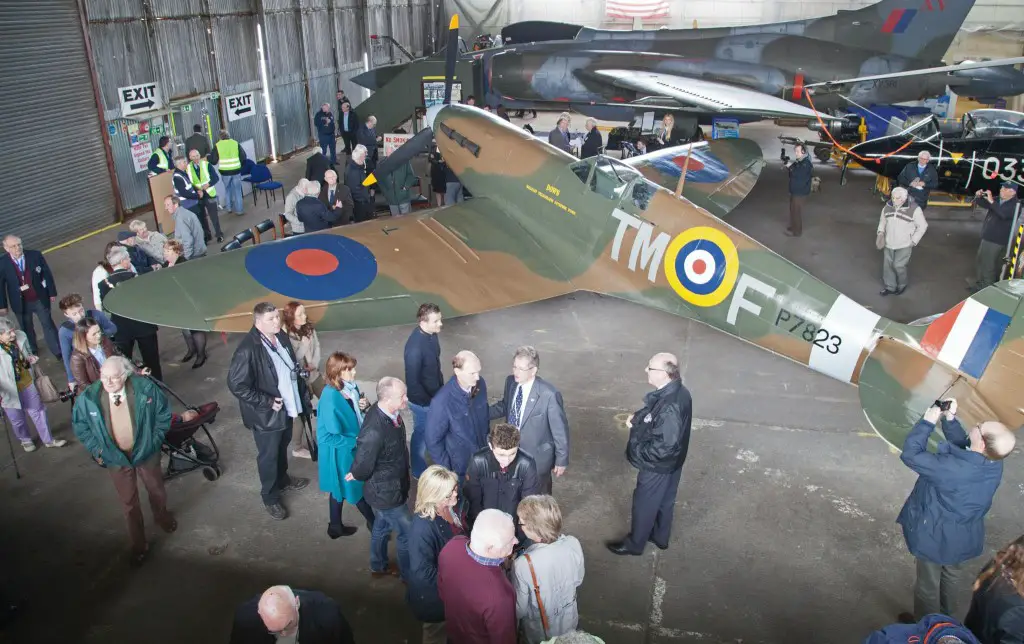In Belfast, Northern Ireland, in the desperate hours of 1940, the local paper began collecting money from loyal Ulstermen to buy the Royal Air Force a plane. And another… and another. In the end, the Belfast Telegraph and its readers’ Belfast Telegraph Spitfire Fund would finance no fewer than 17 Supermarine Spitfires for the RAF.
Of those war machines, only one served at home, in Northern Ireland, with 502 Auxiliary Squadron1. Like the other 16, it’s gone now…
The clock is being turned back at Long Kesh today as a full-scale replica Spitfire bearing the name Down (after Co Down) is unveiled in a poignant ceremony by the Ulster Aviation Society.
The model will also carry the letter code TM-F and serial number P7823 on its side but, more significantly, the slogan Belfast Telegraph Spitfire Fund will be there, too. And thereby hangs a tale dating back to wartime 1941 at RAF Ballyhalbert in Co Down where the real Spitfires carrying those markings served until January 1942 with No 504 Squadron Auxiliary Air Force.
That plane was indeed called Down and was one of 17 Spitfires built for the RAF by donations from the people of Northern Ireland under the auspices of this newspaper.
The Telegraph tells the story with understandable pride; there’s a lot more information there if you’re inclined to Read The Whole Thing™.
The Spitfire is a non-flying replica. Convincing-looking, it’s now on display in the Ulster Aviation Society hangar/museum. The original P7823 crashed in 1942 with fatal consequences for its pilot.
The Ulster Aviation Society has an interesting website, with a page about this and other Spitfires in Northern Ireland (including US Spitfires, and Royal Navy Seafires), and a separate Facebook page with photos from the rededication this week of the Spitfire in its new, NI-related markings.
Why a replica? The demand for Spitfires exceeds the supply. Over 20,000 of them were built from the prewar to early post-war years, but according to Wikipedia2 only 54 survive in airworthy condition worldwide and another 68 on static display, plus 100-odd undergoing or awaiting restoration or stored as parts or wreckage. Of those 200-odd surviving airframes, about 1% of production, only 4 are confirmed Battle of Britain vets — most are later marks.
Notes
- The NI Spitfire unit, according to the Ulster Aviation Society, was 504 Squadron, Aux AF (the party-tine Auxiliary Air Force was not “Royal” until after the war). 502 Squadron was called the “Ulster” squadron, but had bombing types like the Armstrong-Whitworth Whitley, and a Coastal Command mission.
- Usual Wikipedia disclaimers apply… don’t spend money or take risks based on what’s written there.

Kevin was a former Special Forces weapons man (MOS 18B, before the 18 series, 11B with Skill Qualification Indicator of S). His focus was on weapons: their history, effects and employment. He started WeaponsMan.com in 2011 and operated it until he passed away in 2017. His work is being preserved here at the request of his family.




16 thoughts on “Full Circle: The Telegraph Spitfire”
I am having trouble receiving all of the text in the blog. Entire sentances are missing. Can you help?
There is a fairly large culture of folks over there who never grew out of airplanes as a kid from the proliferation of airfields from WWII. Very enthusiastic collectors and researchers of anything and everything that flies. One of the leadership classes before mine got to go help an archeological dig of an airfield and got to recover a lot of history. If you’re into such things a show used to be on over there called Time Team. Mostly it was archeological digs of Iron Age, Saxon, Roman occupation, etc but they did a few WWII-era digs. Some sad stories.
They should be proud of this. I don’t know the going rate for a Spitfire in the 1940’s pound currency but it must’ve been fairly steep.
That was an interesting show to watch. One of my all time favorites was called “Connections”. It went through several seasons, and was absolutely fascinating to watch.
Hognose, this was an interesting story. Thanks for posting this!
I come from the same city as the Spitfire designer, our local museum has some great stuff but it is hard to imagine the same man that designed the elegant Spitfire designed the Walrus seaplane, immortalised at the link below!
http://www.thepotteries.org/location/districts/tunstall/spitfire.jpg
Time Team did some great battlefield archeology on the Somme
If you can get it on YouTube do a search for Large Livens Projector
The trailer is below
https://www.youtube.com/watch?v=dRfYfeFT8g0
A fantastic story from start to finish
Why does the Walrus look like that? Horses for courses. Mission was long endurance, not speed; and short wings were necessary for shipboard applications, hence a biplane configuration… Mitchell’s Walrus design is as ingenious as his Schneider racers or the Spit, IMHO.
Yes, who doesn’t want to see a ginormous flamethrower! All of the Time Team seasons and specials are on YouTube.
My favorite moment is when they unearth the valve, and it looks damn near perfect, and it still works after 90 years in the oxygen- and nitrogen-rich soil of Mametz. “British engineering!” says one of the archaeologists, happily. Guess he never owned a Lotus.
They dig a B24 that was coming on their last mission when it collided with another aircraft. Killed the entire crew. One of the squadron mates was still alive and they interviewed him over the phone. He said he could see some of the crew with celebration cigars right before it happened. Sad story.
The crew’s remains were recovered but the wreckage was left. Most of the tail was intact, they found several of the M2’s and ammo.
They also did a Spitfire crash and recovered some personal items they returned to his brother. Their D-Day special was great. Following the advance of one of their infantry units. They dug some German positions and if memory serves ended up finding mingled 8mm and 303 brass. That’s history.
I watched that show all the time in the late 90’s while stationed there. Still watch it on YouTube when nothing else is worth watching. Hey, who doesn’t want to watch a bunch of British hippies digging in the dirt? Ha!
The D-Day battlefield is a great visit, even if you’re not digging for history. There are dozens of little, private museums where one French amateur or another has dug up parts of Churchill tanks and FW-190 wrecks. Plus all the nations’ graveyard minders are involved in repatriating or reinterring remains.
Cool, did not know that bit of history.
Coincidentally, another gun blog I read recently noted that a flying restored Spitfire dug out of the sands of Dunkirk will be for sale soon. If you want to add this one to your collection of mechanical noisemakers, bring your piggy bank. It’s expected to go for around £2.5 million.
http://onlygunsandmoney.blogspot.com/2015/04/the-ultimate-curio-and-relic-if-you.html
I do so love these little pieces of history you write WM, always thoughtful, interesting and informative. I think I enjoy these the most, from your myriad different styles of posts. This was especially poignant since I live in Belfast, and hadn’t actually heard of the Belfast Telegraph spitfire fund, you learn something new every day. Well, if you read this blog you do.
It is pretty heartbreaking that so few Spitfire’s survived the war, am I correct in recalling a previous post of yours, that after the war Spitfire’s were used for target practice? Seems hard to believe anyone could be so shortsighted….
Right after a war, the obsolete weapons are plentiful and worthless. About 15-25 years later people start waking up to the fact that many of them are gone, especially the weapons of the losing side. One American general ordered that one of each Japanese type be preserved, and that’s the only reason that Japanese aviation technology of WWII isn’t utterly extinct.
The British were the most reckless about preserving their heritage, but it’s kind of understandable. Britain was exhausted after the war and unlike the Continent, didn’t get any Marshall Plan aid. My relatives remember rationing that lasted until the mid or late 50s, and conscription until the 60s. British Defence policy went insane with the Duncan Sandys white paper of 1957.
Maybe for the next war the LA Times will head up a collection to buy a squadron of F-35s for the USAF. Or not.
I’d pay good money to see one get the BRRRRT from a Warthog.
The LA Times would be more likely to buy them for the enemy, whoever that may be.
UPDATE
From a reader who wishes to remain anonymous:
sorry to nitpick here, but britain got the biggest slice of marshall aid.
http://www.bbc.co.uk/history/british/modern/marshall_01.shtml
I’ll be damned. I’ve believed a false “fact” since hearing it in childhood from a bitter English relative.